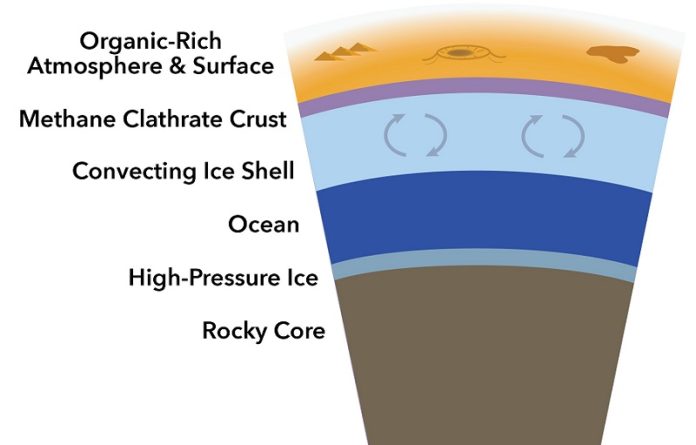
Saturn’s largest moon, Titan, is a unique place in our solar system.
It’s the only moon with a thick atmosphere and liquid rivers, lakes, and seas on its surface, similar to Earth.
However, due to Titan’s extremely cold temperatures, these liquids are not water but hydrocarbons like methane and ethane.
Titan’s surface is made mostly of solid water ice.
A new study led by scientists at the University of Hawai’i at Mānoa suggests that Titan’s icy crust may hold more mysteries.
The research, published in The Planetary Science Journal, found that Titan might have a layer of ice up to six miles (10 kilometers) thick containing methane gas.
This insulating layer, known as methane clathrate, could explain why Titan’s impact craters are much shallower than expected and why its atmosphere is rich in methane.
Lauren Schurmeier and her research team were puzzled by NASA’s data showing only 90 impact craters on Titan—fewer and shallower than seen on other moons. “This was very surprising,” said Schurmeier. “We expected to see many more craters, and much deeper ones, like on other similar moons.”
The researchers created computer models to figure out why Titan’s craters are so shallow. They tested how the moon’s ice shell might react after an impact if it were covered by a layer of methane clathrate, a type of solid ice that traps methane within its crystal structure.
Comparing their models with craters on Ganymede, a similar-sized icy moon, they found that a methane clathrate layer between 3 to 6 miles thick best matched Titan’s observed craters.
This layer of methane clathrate not only shapes Titan’s craters but also insulates the moon’s interior, causing the ice shell to warm and soften. This process allows the surface to “relax” quickly, similar to how fast-moving glaciers on Earth smooth over the landscape.
The study’s findings suggest that Titan’s interior is warmer and more dynamic than previously thought. “Methane clathrate is stronger and more insulating than regular ice,” said Schurmeier. This insulation keeps the ice shell warm and flexible, which could mean that Titan’s ice is slowly moving and mixing.
Understanding the thickness of this methane-rich crust is crucial because it may explain Titan’s methane-rich atmosphere. Methane gas could be slowly released from the clathrate ice, contributing to Titan’s unique “methane cycle,” similar to Earth’s water cycle. This knowledge might also offer insights into methane processes happening on Earth, such as methane release from permafrost in the Arctic.
NASA’s upcoming Dragonfly mission, scheduled to launch in 2028 and arrive in 2034, will provide a closer look at Titan’s surface. One of Dragonfly’s targets will be the Selk crater, which could offer more clues about Titan’s crust and interior.
Schurmeier believes that if life exists in Titan’s ocean beneath the thick ice, any signs of it could be transported through the warm, moving ice shell to the surface. This makes future exploration of Titan’s icy landscape even more exciting.



